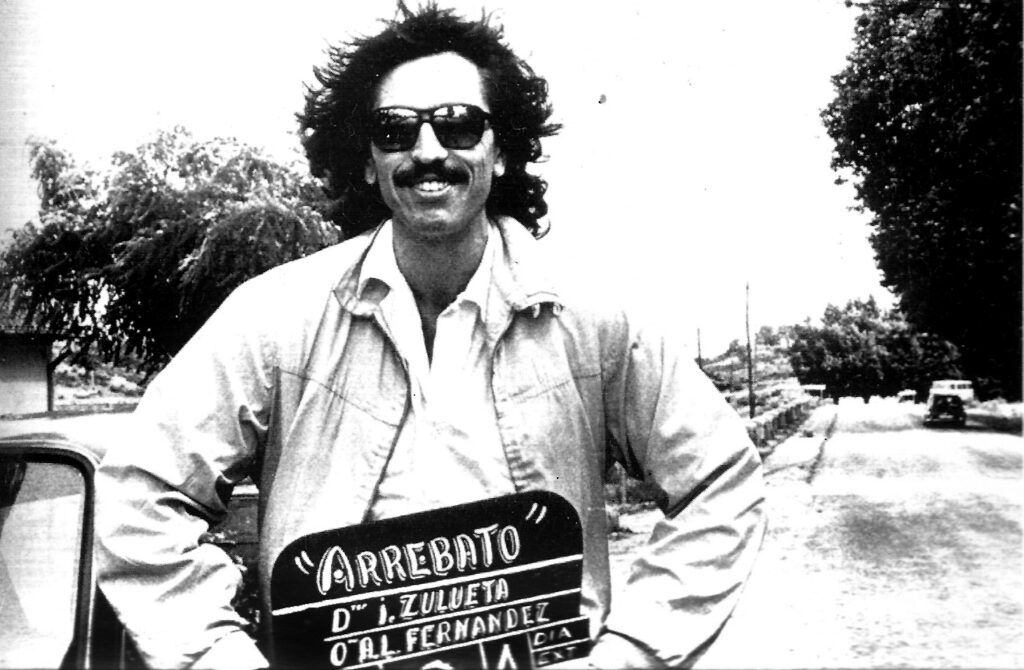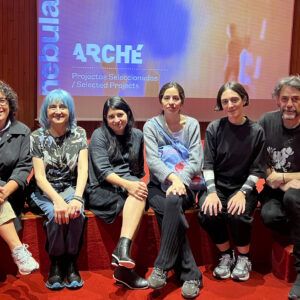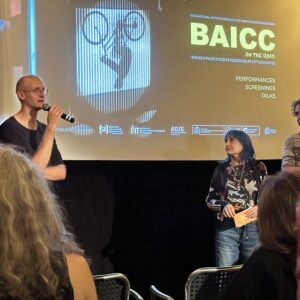Josetxo Cerdán, curator of the A/Z: Zulueta inédito (A–Z: Zuleta unreleased) cycle (which is continuing every Friday in June at the Filmoteca de Galicia) and director of the Filmoteca Española at the time the Zulueta archive was acquired which has given rise to the cycle, tells us together with Miguel Fernández Labayen about the discovery of that fabulous handful of boxes belonging to the artist.

The archive
We could go directly to the date of Iván Zulueta’s death, which was 31st December, 2009. When Iván died, his mother and his two brothers, who were the heirs, were still living, but a short time later the mother and Borja, his little brother, died. When only the older brother Jaime remained, he decided to sell the house that had been the family’s living space seen in Iván’s own films. When that deal was closed, the house was emptied and that was when Virginia Montenegro came into play for the first time, who prevented all that material from going into the rubbish. Virginia was the one who insisted it should be kept, so an agreement was struck for all of Iván’s material in his room to be kept in storage in the same city of San Sebastián, and it remained there for years.
Why did this happen and why didn’t the cultural authorities act before? Talking to Virginia, she says that she made several attempts with different institutions and no one showed much interest. Towards the end of 2019, Miguel Fernández Labayen alerted me, telling me “I’ve spoken with Virginia Montenegro. There’s a problem with Iván’s unreleased works; it seems they have to take them out because they can no longer maintain the warehouses.” At that time I was the director of the Filmoteca Española (Spanish Film Library), and what I was able to do was to provide the facilities of the institution, which is what it’s for. So a visit was arranged and Miguel and I went to San Sebastián at the end of February 2020. We met with Virginia, who was acting as an intermediary, and with the remaining heir, Jaime, the older brother. We visited the warehouses and saw the situation of everything; we saw the conditions that were obviously not conditions for keeping an artist’s material, and we came to a basis for agreement. Jaime was prepared to get the job done, and so were we. There was no talk of a price, only talk about the fact it had to be removed from there. Virginia was delighted with the task and that’s basically what was done with the problem, and just then in the thick of all that they locked us down and everything else that the pandemic brought with it. So, what should have happened in March ended up happening in November, which is when those boxes went to the Filmoteca Española, and from then on the negotiations began. The negotiation with Jaime went very well and throughout that time Virginia was very attentive to help the conversations along. And well, finally, due to how slow the public administration is, even more so in a situation like the pandemic that we were experiencing, when everything is delayed, we ended up finalising the job in the summer of ‘21. And that is when the acquisition was made public. From then on, the whole process of dealing with the material has taken place. The easiest and most immediate thing to deal with were the films, because it is also the most identifiable material, but then you have to deal with all the rest of the material. There were all kinds of material: a lot of documentation, a lot of text, artwork, but there were also books, photographs and records. For example, what was to be done with the records? It was decided to keep the records with any identification saying they were his. There are many where simply the signature says so. Then there are others that have seen some intervention; there are a couple of wonderful records, a couple of singles whose cover he drew because, since his father was in the world of music, the records came to him without a cover for distribution so he would draw it. That’s artwork. There was an extremely meticulous job there, to see what was worthwhile and what wasn’t, piece by piece.
The content of the boxes
Super 8 cannisters for 35 mm, 16 mm and 8 mm turned up, but it is true that the 35 mm acetates were in very bad shape. Two or three cannisters were directly discarded once they reached the archive. We thought that what was inside were materials related to El Último Grito (The Last Cry) and even materials from the parents’ wedding trip. But it wasn’t possible to see them because they had already been destroyed by the vinegar syndrome: they couldn’t be loaded into a scanner, not even into a Moviola because they would contaminate it, so it was decided to destroy them. There are a few 16 mm ones and above all there are Super 8 and 8 mm. The main criterion was to say which material out of all that was material we knew to be by Zulueta and which wasn’t. So we began to create a preliminary classification with the titles that we knew and which were clearly identifiable.
For example, Mi ego está en Babia (My ego is in Babia): you’d find a reel that was pieces of My ego is in Babia, or you’d find the audio of My ego is in Babia in other material; it was derivative material but not the film itself. It was working material. Then there were materials that were not by Iván, for example there was a film entitled Iván’s Christening that obviously he couldn’t have filmed. There were films by his parents; there were three or four films shot in London around the early 60s, which are Jaime’s. There were two wonderful films from ‘59, one of which was entitled El loco (The madman); another one had no title, but it was a kind of parody of a western. There was an opening credit that said “Starring Borja and Jaime, directed by Iván”. We could say that they were the first shorts by Iván Zulueta, who must have been 16 years old at the time. And with all that, we put together the puzzle. On the one hand, there were the materials we knew. On the other, there was everything that we didn’t know and there was another map that had to be drawn up, which was what belonged to Iván and what didn’t; and what belonged to Iván and was related to things we knew, and what wasn’t. For example, there was a movie that said Maroc on the box and it was a trip around Morocco. In the cycle that Iván held in 1989 in Alcalá, one of the films that was shown was called Marruecos, and what we can see from the description in the synopsis perfectly matches what’s in that movie. So our first impulse was to say it was that movie. But we didn’t know. Maybe it’s derivative material. We didn’t have any evidence that it was the film because it has no opening or closing titles. It did coincide in a series of shots with what they were telling us, but we didn’t have any proof, so we decided to put the title of what appeared on the box there, because in that regard we tried to be very orderly; at all times we intended to intervene as little as possible. It was necessary look at the fine print to classify the material. And the process is still ongoing. Now we are looking at the written documentation. We are going to see if we find something that can make us reclassify or rename some titles based on some of the things he left written. What we are going to see is where the work had reached in December last year; it’s a map that may continue to change, especially since Iván did not leave anything written about it.
The cycle
Obviously, you have a series of preconceived ideas of what you are going to find and then reality takes you somewhere else. We had no idea how we were going to present this, because we didn’t know what it was going to be; that is, we didn’t know that we were going to find a hundred reels, since it could have been ten or two or none. So we work as the research process progresses and beat out our own path. In the end you have to let yourself get carried away by the process, and the process led us to a series of materials that we interpreted in a very satisfactory way, not because we found films, because we haven’t, but because on seeing these materials we saw another Zulueta different from the one of the image that we have seen on the screen. One recurring conversation with Miguel is always that there has never been interest in Zulueta; the interest has been for Arrebato and the myth of Arrebato.
So we said to ourselves: let’s go for Zulueta, the artist, and Zulueta the person, but beyond Arrebato. At last we were handling material that allowed us to work on the man. Zulueta no longer existed, and if you follow what he said in the press he was very elusive; he never said anything, he always downplayed everything. Nevertheless, he wrote his diaries, and the film material also works at that level of description, about what could have been going through his head. There were many things that no one had cared about, or that no one had been interested in, because normally what people are interested in is Arrebato and everything the giant film masterpiece constructed. Those films gave us that, and the archive in general gave us that other side where we intended to go.
The films
There are a series of films that are simply family heritage, in other words, the history of the family, which in the end are the ones that have ended up making up one of the programmes, which is “The films of Consuelo and Antonio.” The rest gives us access to the artist’s workshop, which also appeared with all the graphic part: folders and folders of clippings and things, and photocopies, and colours…that is, we don’t have unreleased films by Zulueta, but rather we have his workshop. We have the things he didn’t use; we have different montages. My ego is in Babia is a film that we were watching and suddenly we realized that what was in it had nothing to do with what appeared, like the attempts to create some credits. So there was a movie that was My ego is in Babia that everyone thought we knew, but then we saw on the folder that that wasn’t the title, but Babia. So there was a missing film from five years before, but nevertheless, when Iván talked about the film Babia, he talked about My ego is in Babia, but My ego is in Babia is also something else because materials appeared in the folder. That process is wonderful. So, what are these movies, aesthetically? They are clips; they are waste material, tests and then the last programme, “Notes and sketches”, are films that were practically finished but for some reason he didn’t want to show them. There are also movies in other programmes, for example, California is clearly a finished film but he never wanted to show it. Another example is Piscina (Pool), a film that is practically finished. Why didn’t he show them? Well, possibly because he forgot them; because he suddenly turned to something else in his complete hyperactivity, because he didn’t rate them or because he didn’t have the opportunity to show them, because from a certain moment onwards, Iván was only asked for the same old, same old: what people already knew. They ask him for Leo es pardo, Mi ego está en Babia, and he worked on those.





